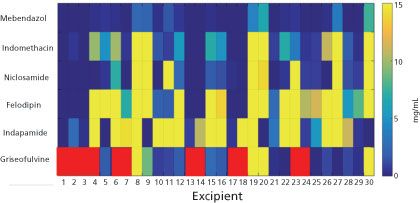High Throughput Screening of Excipients
The author discusses the advantages of high-throughput screening of drug formulation excipients by a fully automated Tecan-robotic system.
CA-SSIS/shutters tock.com

During early drug development, compounds have to be characterized for their toxicology, bioavailability, pharmacokinetics (PK), and pharmacology profiles. To carry out characterization studies, the compound must be dissolved in solution at a concentration that is high enough to achieve a therapeutic effect. Low aqueous solubility can, therefore, be a major challenge in drug development.
Current methodologies
Methods to improve solubility include chemical modifications, physical modifications, and solvent modifications. The method selected will be based on the compound’s chemical properties, the physical state of the formulation, and the route of administration. In the development of liquid formulations, solvent modifications and carrier systems are most commonly used because they affect only the solvation characteristics of a drug rather than its solid-state properties.
Excipients can be used to optimize the solubility of poorly soluble compounds. Traditionally, the selection of excipients relies on a trial-and-error-based approach involving a number of research-based methodologies to determine the ideal excipients. Although often successful, in reality, this approach is time-consuming, costly, and demands large amounts of material.
Developing a high-throughput screening method
A high-throughput screening method has been established to overcome the challenges of selecting one or more excipients. The aim was to develop a methodology that would use minimal amounts of API, while providing a cost-effective and efficient way to achieve results. It was also a prerequisite to establish a platform that could provide conclusive information about a compound’s chemical stability in varying solvents and excipients.
Several experiments were performed to establish the methodology. The screening list involved excipients with varying solubilization mechanisms, including water-soluble organic solvents, non-ionic surfactants, water-insoluble lipids, organic liquids/semi-solids, cyclodextrins, and phospholipids.
The type of excipients used will depend on the drug delivery system. Orally administered compounds, for example, will require different excipients than injectables. There is also a need to ensure that the final concentration of the selected excipients is within the generally recognized as safe (GRAS) list of recommended concentrations. The identification of the correct excipient in its individual correct maximum concentration is important, especially for parenteral formulations, because doses that are too high can cause pain, hemolysis, or inflammation.
A new methodology
The high-throughput screening platform is based on identifying the solubilization capacity of each excipient for a compound. It can also shorten the time taken to identify an excipient by allowing multiple tests to be performed simultaneously.
The method was initially developed using six commercially available drugs (see Figure 1) with diverse chemical properties. Testing was conducted using 30 excipients dispensed in 96 well-plates via a fully automated robotic system (Tecan). Three plates were studied for each compound. The plate was shaken for 48 hours to achieve equilibrium. The results were compared with solubility measurements performed using a manual shake flask method where 15 mg of powder and 2 mL of excipient were added. The samples were again shaken for 48 hours, centrifuged, and then analyzed by high-performance liquid chromatography (HPLC) to determine solubility and detect any degradation. The measurements were performed in triplicates.
Figure 1: Solubility of the drugs in the excipients. 15 mg/mL was set as the maximum amount, with degradation of the drug indicated in red. [Figure 1 is courtesy of the author.]

Findings
Some excipients have been shown to offer better solubilization capacity than others; the trend varies between compounds (see Figure 1). For ionizable compounds, pH-dependent solubility is a useful approach, especially if it can be combined with another solubilizing excipient. The contribution of solid-state barrier to solubilizing a compound appears to be more pronounced at a cut-off level of solid-state properties. Before this cut-off, the solubilization of the compound was more compound specific, which creates the need to also test on a larger set of excipients.
The results of the high-throughput screening method demonstrate that solubility using this technique is not statistically different than that achieved when using a manual approach. The method can provide information on the solubilization capacity of compounds in different excipients, while also offering insight into stability.
The high-throughput screening method overcomes the challenges associated with manual approaches by being more cost-effective and economical in the use of materials, while turning around results in three to five days per set of compounds.
Conclusion
The development of the platform has created new possibilities for reduced drug development timelines and costs. Furthermore, the information generated in the screening is useful in the later stages of formulation development. Helping to boost the probability of successful formulation, selecting excipients based on an API’s unique molecular properties offers a faster process that can revolutionize the way developers evaluate the solubility of any compound.
Article Details
Pharmaceutical Technology
Supplement: Solid Dosage Drug Development and Manufacturing
March 2018
Pages: s23–s24
Citation
When referring to this article, please cite it as A. Alhalaweh, “High Throughput Screening of Excipients," Pharmaceutical Technology Solid Dosage Drug Development and Manufacturing Supplement (March 2018).
About the Author
Amjad Alhalaweh, PhD, is a formulation scientist at Recipharm.

Drug Solutions Podcast: A Closer Look at mRNA in Oncology and Vaccines
April 30th 2024In this episode fo the Drug Solutions Podcast, etherna’s vice-president of Technology and Innovation, Stefaan De Koker, discusses the merits and challenges of using mRNA as the foundation for therapeutics in oncology as well as for vaccines.
Drug Solutions Podcast: Applying Appropriate Analytics to Drug Development
March 26th 2024In this episode of the Drug Solutions Podcast, Jan Bekker, Vice President of Business Development, Commercial and Technical Operations at BioCina, discusses the latest analytical tools and their applications in the drug development market.
INTERPHEX 2025: Use of Walk-In Chambers for Bio/Pharma Development and Manufacturing
April 2nd 2025Sitting down with the PharmTech Group at INTERPHEX 2025, Christopher Murphy, director of Global Business Development and Service Customer Support at Environmental Specialties, discusses the design and critical role of walk-in chambers in the bio/pharmaceutical industry.